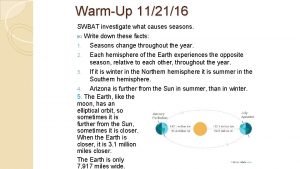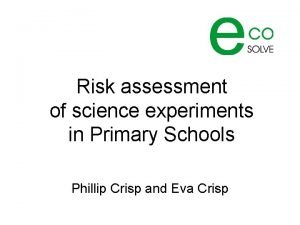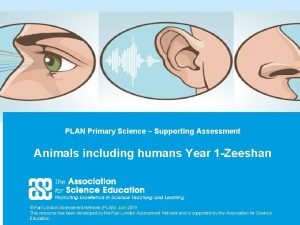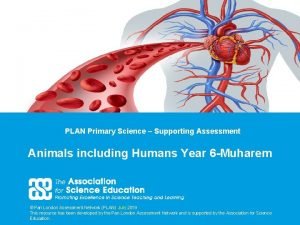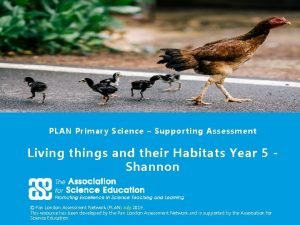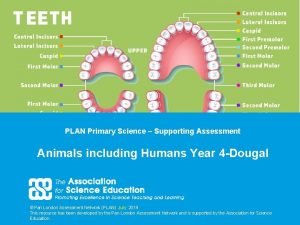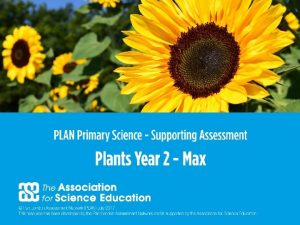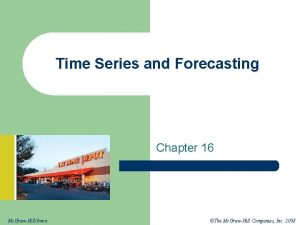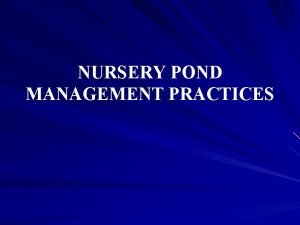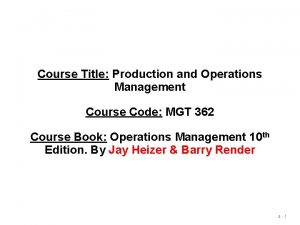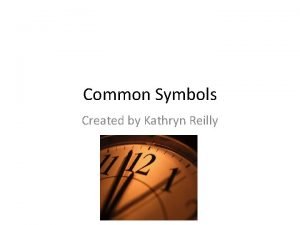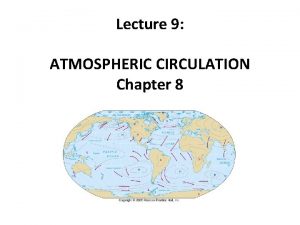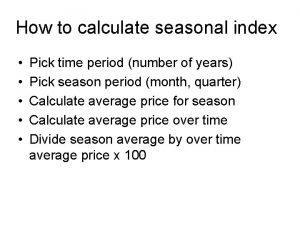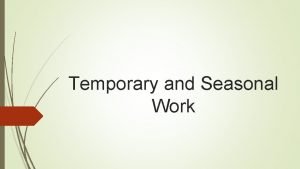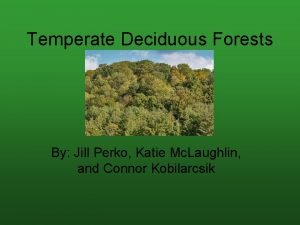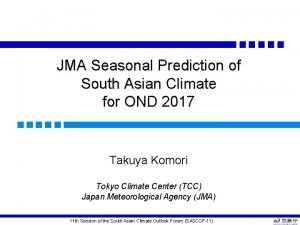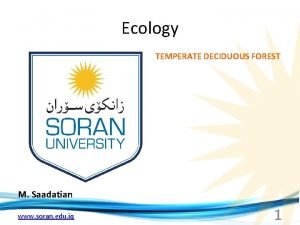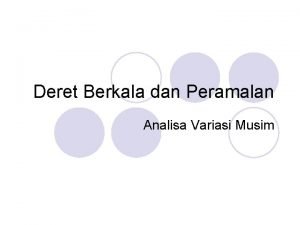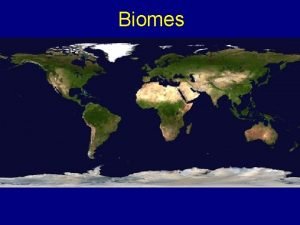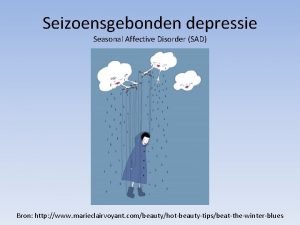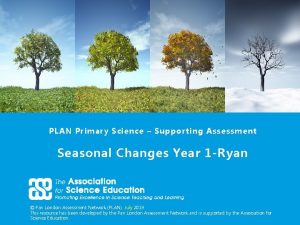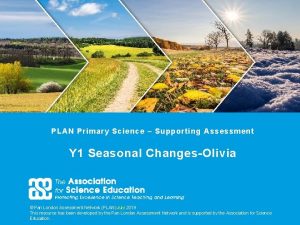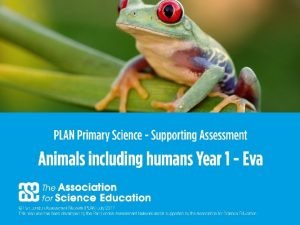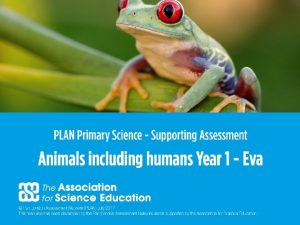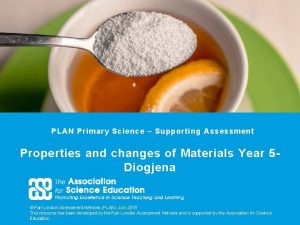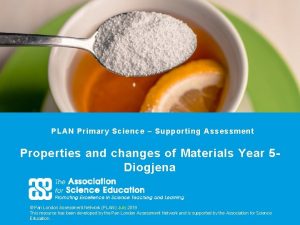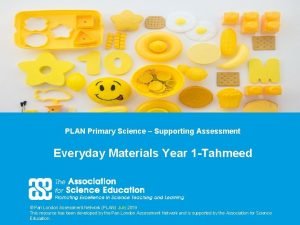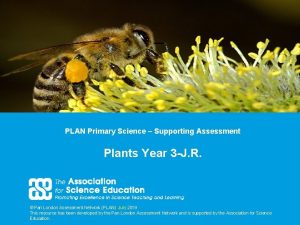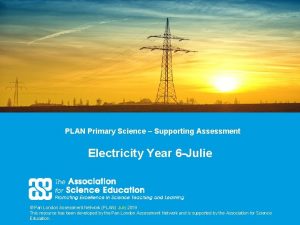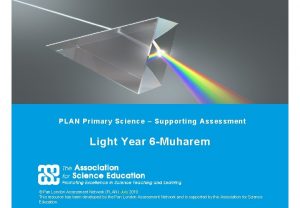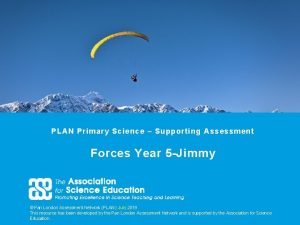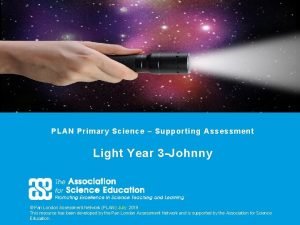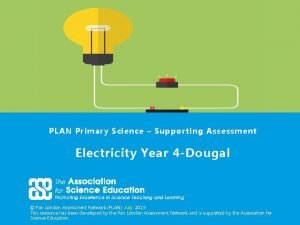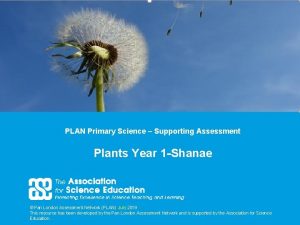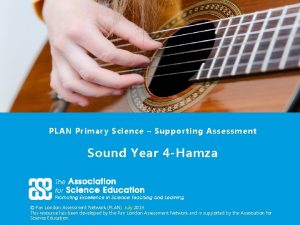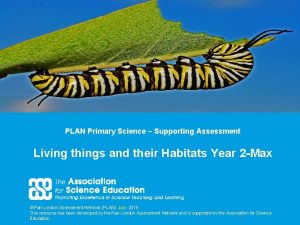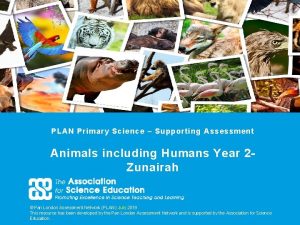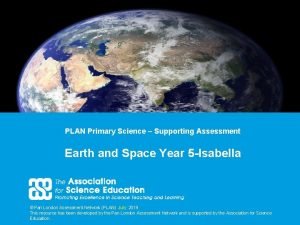PLAN Primary Science Supporting Assessment Seasonal Changes Year
































- Slides: 32

PLAN Primary Science – Supporting Assessment Seasonal Changes Year 1 -Ryan © Pan London Assessment Network (PLAN) July 2019 This resource has been developed by the Pan London Assessment Network and is supported by the Association for Science 1 Education.

PLAN Primary Science - Supporting Assessment PLAN Primary Science is a set of resources produced to enable teachers to have a clearer understanding of National Curriculum expectations for meeting the standard. Annotated collections of children’s work provide examples of what working at the expected standard for primary science might look like for the knowledge and conceptual understanding statements of the programmes of study (POS). It is not the intention of these resources to specifically exemplify the working scientifically statements. However, aspects of working scientifically have been shown as an integral part of the teaching and learning of the knowledge and concepts. The resources provided have been cross moderated multiple times before publishing so that they can be used with confidence by teachers and subject leaders. Each collection of work shows one example of how a pupil has met National Curriculum statements for a particular area of content but these are not intended to be the definitive way of teaching these statements. 2

Structure of the resources Each resource contains the relevant National Curriculum statements for the unit of work and prior learning, a planning matrix, annotated work and a summary sheet. The matrix provides an interpretation of the key learning of the National Curriculum statements, and suggestions of key vocabulary. In order to be meet the expectations pupils must firstly understand the key concept and then be provided with opportunities to apply that knowledge. This is a key planning tool. Key Learning Secure Possible Evidence Show Overview paragraph describing understanding of a curriculum concept by using scientific Key vocabulary – list of words vocabulary correctly Possible ways to demonstrate key learning, particularly correct usage of vocabulary Apply knowledge Suggestions of contexts to use. in familiar related contexts, including a range of enquiries Possible ways to demonstrate that a pupil has gone beyond recall of facts and can apply the key learning, for example using the vocabulary and basic principles to produce explanations, usually within Working Scientifically contexts. 3

Contents of the materials Please note: The NC statements for each topic area for the relevant year group are stated on the slide. Only the statements in bold on that slide have been exemplified. In these cases the teachers have chosen to split the statements within the topic area to teach at different times. The prior NC statements relevant to the topic area are also stated and use to determine pupils’ knowledge at the start of the unit. Each slide has been annotated with coloured text. Please see key below: Red Commentary to explain how evidence meets/does not meet NC statements Blue Commentary to highlight features of working scientifically Green Pupil Speak Grey Other relevant information eg. vocabulary used 4

Year 1 Statements Pupils should be taught to: • observe changes across the four seasons (1 -Seasonal Changes) • observe and describe weather associated with the seasons and how day length varies. (1 -Seasonal Changes) 5

Later Statements Pupils do not need to be taught content they will learn in later year groups. They can be challenged by applying the content for their year group in broader contexts. In Year 3 pupils will be taught to: • recognise that light from the sun can be dangerous and that there are ways to protect their eyes. (3 -Light) In Year 5 pupils will be taught to: • use the idea of the Earth’s rotation to explain day and night and the apparent movement of the sun across the sky. (5 Earth and Space) In Key Stage 3 pupils will be taught about: • the seasons and the Earth’s tilt, day length at different times of year, in different hemispheres.

Key learning Evidence Shows understanding of a concept using scientific vocabulary correctly In the UK the day length is longest at mid-summer (about 16 hours) and gets shorter each day until mid-winter (about 8 hours) before getting longer again. The weather also changes with the seasons. In the UK it is usually colder and rainier in Winter and hotter and dryer in the Summer. The change in weather causes many other changes, some examples are numbers of minibeasts found outside, seed and plant growth, leaves on trees and type of clothes worn by people. Key vocabulary Weather (sunny, rainy, windy, snowy etc. ) , Seasons (winter, summer, spring, autumn), Sun, sunrise, sunset, Day length Can name the four seasons and identify when in the year they occur. Can observe and describe weather in different seasons over a year. Can observe and describe days as being longer (in time) in the summer and shorter in the winter. Applying knowledge in familiar related contexts, including a range of enquiries Describe the general types of weather and changes in day length over the seasons. Describe some other features of their surroundings, themselves, animals , plants that change over the seasons Can collect information to classify weather and day length in different seasons and present the information in tables or charts to compare the seasons. Can collect information on features that change with seasons and present in displays. SECURE Assessment guidance

Firstly weekly trip to the playground • observe changes across the four seasons This was the first trip outside and the focus was on looking generally for interesting things. Ryan talked about the colour and shape of different leaves. He talked about the ones on the floor being dead. He knew this meant it was Autumn. Image from the class floorbook – this records learning of all the children in the class. Additional comments made by Ryan are shown in green. 8

Trip to the playground to observe changes to the plants • observe changes across the four seasons This lesson focussed on looking at and comparing the leaves on the ground and those still on the plants Ryan noticed that the leaves on the trees and those on the floor were different colours. Some leaves that he found were more than one colour. He also noticed there were some plants that still had green leaves. Image from the class floorbook 9

Trip to the playground to observe changes to the plants • observe changes across the four seasons Whilst outside all the children chose a leaf to bring back to class. They described their leaf to a partner. ‘My leaf is smooth and shaped like a flower. Ellie’s was crunchy and pointy. ’ Image from the class floorbook 10

Trip to the playground to observe changes to the plants • observe changes across the four seasons Whilst outside all the children chose a different a leaf to bring back to class. They were then asked to draw them really carefully to get the shape and colour as accurate as possible Some leaves are smelly. Some felt really soft. I can’t draw that though. Ryan is using all his senses to describe his leaf. Image from the class floorbook Ryan’ s drawings of different leaves he found and identified. 11

Recording the weather over a three week period • observe and describe weather associated with the seasons In November, the children went out every day to look at the weather. They chose the symbol that best matched the weather and also looked at the ground to see whether it was wet or dry. Each day two children chose the most appropriate symbol and added it to the class chart. Ryan chose the correct symbol to match the weather. Ryan placed the symbol in the correct place on the chart. ‘The clouds are very grey so it might rain again. ’ Image from the class floorbook 12

Presenting and reviewing date of the weather over a three week period • observe and describe weather associated with the seasons The teacher drew the axes for the bar chart and placed the symbols below the x axis. In pairs the children decided where to put their symbol taken from the chart in order to complete a bar graph. Ryan stuck his symbol onto the correct place on the bar chart. Data gathered in the November Image from the class floorbook Ryan noticed that there were four rainy days and four cloudy days and only 2 sunny days. 13

Recording day length over a period of time • observe how day length varies. From the start of the year each night Barry Bear went home with a child and they recorded what they did with him. They also had to put Barry Bear to bed when it got dark. We played Fifa and watched the Minion new movie We played loom band with him and we built a tall tower. We watched TV. I played with my sister These diary entries from December show that it was getting dark early – between 4 pm and 5 pm. The children were also spending time inside. 14

Recording day length over a period of time • observe how day length varies. At the start of December, the teacher read out the diary entries for the previous few weeks. The children thought about the types of activities that Barry Bear did whilst with the different children. They observed that he mostly stayed in the house watching TV or playing games. ‘I like to go straight home after school because it is cold and dark. ’ Image from the class floorbook 15

Discussing what the weather is like in winter • observe and describe weather associated with the seasons The teacher showed the children a range of different types of clothing and they talked about which ones they would wear in winter. ‘In winter it is often cold so you have to wear a hat and scarf to keep warm. ’ Independently Ryan mentioned that it is dark by the time he gets home now. This shows that he shows an awareness of the current day length. 16 Image from the class floorbook

Trip to the playground to observe changes to the plants • observe changes across the four seasons The class went outside again and looked for things that had changed since before Christmas. Before going out Ryan predicted that there would be fewer leaves. Image from the class floorbook 17

Discussing what the weather is like in winter • observe and describe weather associated with the seasons Image from the class floorbook Ryan’s winter poem 18

Discussion after listening to stories about animals that migrate or hibernate in winter • observe changes across the four seasons During their weekly trips out into the playground the children had noticed that they were seeing fewer birds and squirrels. To help them to think about this the teacher read a selection of stories about animals that hibernate or migrate during winter. Ryan shows here that he understands that the reason some birds migrate is due to the change in the weather. Image from the class floorbook 19

Surveying people’s favourite weather • observe and describe weather associated with the seasons The children were given an outline table and chose four types of weather to add to the left hand column. They then asked everyone in the class which was their favourite and tallied the results. Ryan completed the table and tallied the answers given by his classmates. Image from the class floorbook 20

Discussing what the weather is like in winter • observe and describe weather associated with the seasons The children were then asked to talk to their partner about what their tally charts told them. ‘Most people said snow, but it doesn’t snow very often. Not many people like the wind. ’ Ryan interprets his data. This comment from Ryan shows that he is aware of the need to gather data carefully. The word fair is not used scientifically correctly. Image from the class floorbook 21

Trip to the playground to observe changes to the plants • observe changes across the four seasons The children went out into the playground again to look at how the plants had changed. ‘There are more flowers than last time. Some of the trees don’t have leaves but have blossom instead. ’ Ryan is able to compare what he sees on this trip with previous visits. Image from the class floorbook 22

Trip to the playground to observe changes to the plants • observe changes across the four seasons The children went out to the playground again to look at how the plants had changed. ‘The trees are starting to grow leaves. We might see butterflies and bees next time. ’ Ryan is aware of some of the animals he may see in the playground. Image from the class floorbook 23

Trip to the playground to observe changes to the plants • observe changes across the four seasons The children went out to the playground again to look at how the plants had changed. ‘We found some bugs this time. That is because it is not so cold so they are not hiding away anymore. ’ ‘It is definitely now spring because the trees have grown new leaves and there are lots more flowers. Image from the class floorbook 24

Recording day length over a period of time • observe how day length varies. This is the diary entry made by Ryan in June. ‘We don’t always go straight home. Last night I went to Mc. Donalds. Then we could still play in the garden as it didn’t get dark until late. ’ Ryan’s comments here show that he is aware of how the day length varies across the different seasons. Barry’s bed time is much later in the summer. 25

Trip to the playground to observe changes to the plants and animals • observe changes across the four seasons The children went out to the playground again to look at how the plants had changed and to look for animals. Image from the class floorbook Ryan noticed there were more mini beasts in the playground now such as bees, beetles, snails, spiders and ants. He noticed the weather was warmer so we didn't need our jumpers on and there were lots more flowers blooming and leaves on the trees. 26

Presenting and reviewing date of the weather over a three week period • observe and describe weather associated with the seasons During the first two weeks of July the children again went out daily to record the weather. They then compared this data with those they had gathered in the winter. Data gathered in July Data gathered in the November ‘In this week in winter there was more sun and less rain than this week. I did not expect this. ’ Ryan interprets the data in the chart and make comparisons. 27

Discussing what the weather is like in winter • observe and describe weather associated with the seasons Sun is hot Umbrella is for shade More ice-creams Melting ice lollies Enjoying the sun Remember to wear sunglasses ‘Yesterday and today have been like summer. The sky is really blue. It is really hot. We had dinner in the garden last night. My Mum put the fan in my room because I was too hot in bed. ’ Ryan has composed this summer poem drawing on his recent experiences. Ryan’s summer poem 28

Letter to Olaf (from Frozen) • observe changes across the four seasons • observe and describe weather associated with the seasons and how day length varies. With the teacher, the children looked through the whole of their floorbook to remind themselves of their observations across the year. . They were then asked to write a letter to Olaf to tell him about the other seasons that he has not experienced. In this writing, Ryan summarises some of the key differences between the seasons. This alone would not be sufficient to judge Ryan as secure but taken in conjunction with the evidence gathered through the year, shows that he has met these two objectives. 29

Letter to Olaf (from Frozen) • observe changes across the four seasons • observe and describe weather associated with the seasons and how day length varies. This piece of writing from another child in the class shows that although they were given a framework, so that the start and end to the letter are the same, Hannah has chosen to write about different features of the season to Ryan. 30

Overall Summary Secure Over the year Ryan has explored the different seasons and how they affect plants, animals and himself. He can talk about the weather in each season and give similarities and differences. He recognises that the weather and seasons affect the behaviour of animals and people. He has shown on more than one occasion that he understands that days are shorter in winter and longer in summer. He can talk about how the plants change through the year, describing how blossom and flowers appear, and plants lose their leaves, at different times. Over a period of time Ryan was able to observe the weather and collect data to look for patterns. Ryan can describe the weather commenting on whether it is typical for the season e. g. it is summer now, but it is more rainy than I expected. 31

Acknowledgements All materials were created in the school 32
 What causes the seasons to change? *
What causes the seasons to change? * Elizabeth mulroney
Elizabeth mulroney Ano ang chemical change
Ano ang chemical change Science risk assessment primary school
Science risk assessment primary school Plan primary science
Plan primary science Plan primary science
Plan primary science Plan primary science
Plan primary science Digestive parts
Digestive parts Plan primary science
Plan primary science Her favourite subject be english
Her favourite subject be english Primary and supporting instruments
Primary and supporting instruments Instrument cross check
Instrument cross check Twinkl leavers poem
Twinkl leavers poem Lesson 1 thermal energy and the behavior of matter
Lesson 1 thermal energy and the behavior of matter Seasonal index
Seasonal index How to calculate average seasonal variation
How to calculate average seasonal variation Pre stocking management
Pre stocking management Seasonal unemployment example
Seasonal unemployment example How to calculate average seasonal variation
How to calculate average seasonal variation Symbolism of seasons
Symbolism of seasons From statsmodels.tsa.seasonal import stl
From statsmodels.tsa.seasonal import stl Seasonal movement definition
Seasonal movement definition What is ferrel cell
What is ferrel cell How to calculate seasonal index
How to calculate seasonal index Seasonal work meaning
Seasonal work meaning Characteristics of temperate deciduous forest
Characteristics of temperate deciduous forest Pra meaning
Pra meaning Jma seasonal forecast
Jma seasonal forecast Seasonal allergies icd10
Seasonal allergies icd10 Temperate seasonal forest plant adaptations
Temperate seasonal forest plant adaptations How to calculate seasonal variation
How to calculate seasonal variation Savannah climatogram
Savannah climatogram Symptomen van seasonal affective disorder
Symptomen van seasonal affective disorder
